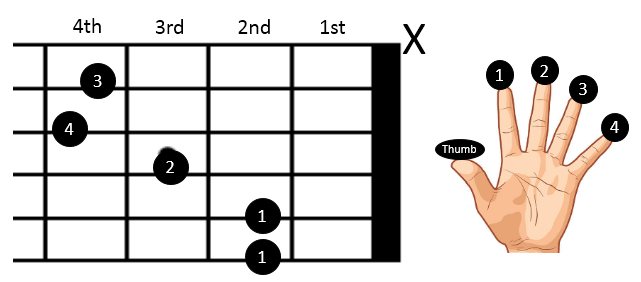
F# Major Chord:-
Place 1st(index) finger on second fret of 1st and 2nd string.
your 2nd(middle) finger on the third fret of the third string,
your 3rd(ring) finger on the fourth fret of the fifth string and
your 4th(little) finger on the fourth fret of the fourth string.
Strum all the strings except 6th string.

F# Major (Barre) Chord:-
Barre 1st(index) finger across all six strings on the second fret.
your 2nd(middle) finger on the third fret of the third string,
your 3rd(ring) finger on the fourth fret of the fifth string and
your 4th(little) finger on the fourth fret of the fourth string.
Strum all the strings.
Here are some practical tips for mastering the F# guitar chord:
1. Understand the Basics:
- The F# chord is a bar chord, often played on the second fret. It’s essential to press down all the strings firmly with your index finger to ensure a clean sound.
- The standard F# major chord is played by barring all six strings at the second fret and forming an E major shape with your other fingers.
2. Focus on Pressure and Positioning:
- Ensure your index finger applies even pressure across all the strings. If some strings sound muted, try adjusting your finger position slightly.
- Keep your thumb positioned behind the neck of the guitar, applying counter-pressure to help with the barre.
3. Practice the Barre:
- The F# chord requires a full barre, which can be challenging for beginners. Start by practicing just the barre, ensuring all strings ring out clearly.
- Gradually add the other fingers as you become more comfortable with the barre.
4. Use Alternate Fingerings:
- If the full barre is too difficult, try playing an easier version by only barring the top four strings (E, A, D, and G strings) and leaving out the bottom two.
- Alternatively, you can play an F#7 or F#m chord, which are easier variations.
5. Build Finger Strength:
- Regular practice will help build the finger strength needed to play the F# chord cleanly.
- Incorporate finger exercises into your daily routine to develop dexterity and endurance.
6. Practice Transitions:
- Work on transitioning smoothly between the F# chord and other chords. Start slow and gradually increase your speed.
- Practice common chord progressions that include F# to improve your fluidity.
7. Use a Capo:
- If you’re struggling with the barre, use a capo on the second fret and play an E major shape, which will give you the F# chord sound.
8. Focus on Clean Sound:
- Strum each string individually to ensure each note is clear. If any strings are muted, adjust your fingers or apply more pressure.
9. Be Patient:
- Mastering the F# chord can take time, especially if you’re new to barre chords. Be patient and consistent with your practice.
By following these tips, you’ll be able to play the F# guitar chord with confidence and clarity.

One thought on “F# Guitar Chord Made Easy: Beginner’s Guide with Practice Tips”